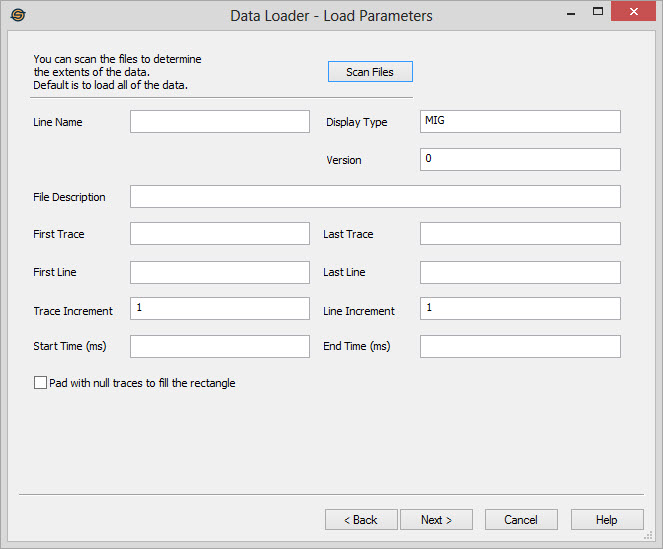Data Loader: Load Parameters
Use the Load Parameters page to
specify 3D load parameters that will
determine the
final output of the 3D survey you are importing. For a line
to be considered a version of another line it has to have the exact
same Line
Name and a different Type and/or Version Number assigned to it. If you
are loading another version of a 3D survey make sure the
Line Name is
the same.

 Scan
Files: This
step is optional - you can scan the input files to determine the
extents of your
data. This process normally takes a long time, but can be
very
useful if you are trying to pad out your data or you only wish to load
a subset of the survey.
Scan
Files: This
step is optional - you can scan the input files to determine the
extents of your
data. This process normally takes a long time, but can be
very
useful if you are trying to pad out your data or you only wish to load
a subset of the survey.Line Name: Specify a line name for the survey. The line name can be up to 32 characters in length.
Display Type: Use this to specify the type of data. This will help you identify different versions of a survey. The default is MIG for migrated data. The maximum length of the display type is 64 characters. It is recommended that you not include numbers, spaces or punctuation characters in the display type. The display type is used to create a unique name for each file. The SeisWare file naming convention is LineID.DisplayType.Version.sgy.
Version: Specify a version number for the file. This must be a positive integer value. This is used to distinguish different versions of a line and helps to uniquely identify a file. The SeisWare file naming convention is LineID.DisplayType.Version.sgy.
File Description: Give an optional file description for the survey. Typical uses for this might include processing history.
First Trace: Specify the first trace in each inline to load. The default is to load all traces. This item needs to be set when padding the survey.
Last Trace: Specify the last trace in each inline to load. The default is to load all traces. This item needs to be set when padding the survey.
First Line: Specify the first line to load. The default is to load all lines.
Last Line: Specify the last line to load. The default is to load all lines.
Trace Increment: Specify the increment in the trace direction. Normally you will leave this as one, but you can set it to some other value to decimate your survey.
Line Increment: Specify the increment in the line direction. Normally you will leave this as one, but you can set it to some other value to decimate your survey.
Start Time/Depth: Specify the start time of the data to load in milliseconds or meters/feet. Normally you will leave this blank in which case the data will be loaded from the first sample. Override this value to load a subset of each trace which will save disk space.
End Time/Depth: Specify the end time of the data to load in milliseconds or meters/feet. Normally you will leave this blank, in which case the data will be loaded up to the last sample in each trace. Override this value to load a subset of each trace. This will save disk space. You also might wish to specify a different end time when you need to truncate your data because it contains junk values at the end.
Pad with null traces to fill the rectangle: Check this item to fill the ends of irregular surveys with null traces to make the survey completely uniform. Each line in the survey will have the same number of traces. When choosing this option you also need to specify a First Trace and Last Trace value.
— MORE INFORMATION

|
Copyright © 2020 | SeisWare International Inc. | All rights reserved |